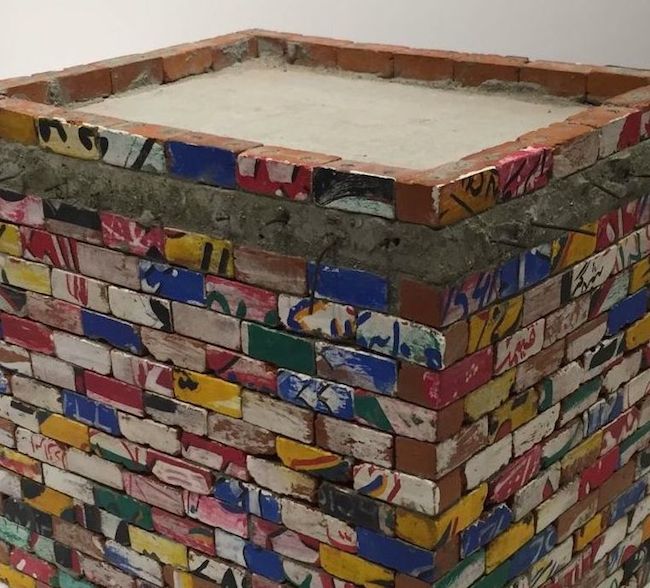Noor Ali Chagani was raised in Karachi, Pakistan. His current exhibition there, House of Bricks (New York, January 14 – February 13, 2016), shows Chagani weaving tapestries of brick, all while exploring the meaning of brick as an object.He majored in computer science in Karachi and then later obtained his BFA in Miniature Painting from the National College of Arts, Lahore. He felt the call of contemporary ceramics. Today he makes works comprised of hand-made miniature terracotta brick, combining both sculpture and miniature painting. Leila Heller Gallery states that his work “revolves around the concept of the absence of home; his quest for a personal space that he can call his own.”
An ode to his training, Chagani constructs his own miniature terra cotta bricks by using old-fashioned kilns and firing methods. He then applies tiny brush strokes to fluidly depict combined and reappropriated imagery seen in the streets of his hometown. Most recently, he has also begun incorporating weaving of bricks into his production, further expanding on the formal possibilities of his techniques.
In this first solo exhibition of his career, Chagani expands upon the initial reasons he has used bricks throughout his career. Bricks are the basic unit with which homes in Pakistan were, and in many cases still are, built. Drawing on his personal experiences, Chagani’s sculptures explore questions of identity and represent his longing for stability in a sound house:
“The brick is a unit that is used repetitively; it is a unit of strength, power and support. It talks about land ownership and possession. It shows a constant struggle between retaining one’s identity and yet blending with the masses. It also communicates the need to be a part of a strong organization.”

Noor Ali Chagani, The Other Side, 2015, terracotta bricks, 59.5 x 32.5 x 0.5 inches

Noor Ali Chagani, Rooftiles Vertical, 2015, terracotta bricks, 24 x 19.25 inches. Click to see a larger image.
Just as each brick is a small segment adding up to a whole, each artwork in House of Bricks consists of various elements which make up a physical edifice such as a home.
Chagani creates various foundational structures such as a roof, floors, walls, stairs and pillars in addition to objects found in homes such as a mirror, a console, and books. He explains, “We spend our lives developing our own house. It’s partly the greatest dream of one’s life. All the struggles, efforts, and savings are to accomplish this wish of building one’s own house.” Chagani expands his range of practice by creating a cohesive and conceptually balanced new body of work allowing him to fully explore what it takes to build a home.

Noor Ali Chagani, Carved Book, 2015, book and terra cotta bricks, 9.25 x 12 x 1 inch
Chagani exhibited in solo and group exhibitions in Pakistan, India, UAE, UK, Netherlands, Bahrain and United States. His first exhibition in the US was ETHEREAL, at Leila Heller Gallery, New York curated by Dr. Amin Jaffer. Chagani was nominated for the Victoria and Albert Museums prestigious Jameel Art Prize 2011. He was awarded with guest residency in Rijks Academy, Netherlands in 2012 and Riwaq Art Space residency in Bahrain 2013. Chagani’s artwork has been featured in numerous publications such as Los Angeles Times, Asia Pacific Arts, L’Opitimum n°23, Global Citizen 13 magazine, Nafas Art Magazine and several daily local newspapers.
Text (edited) and images courtesy of Leila Heller Gallery.
What do you think of Chagani’s contemporary ceramics and brick work? Be sure to weigh in in the comments.

Noor Ali Chagani, Rooftiles Horizontal, 2015, terra cotta bricks 28 x 11.5 inches

Noor Ali Chagani, Lifeline with Colored Bricks, 2015, terracotta bricks, 40 x 54 x 0.5 inches. Click to see a larger image.

Noor Ali Chagani, It’s Not Enough 2, 2015, terracotta bricks, 8 x 22.5 x .5 inches

Noor Ali Chagani, Golden Wall, 2015, terracotta bricks and goldleaf, 11 x 8.8 x 0.5 inches

Noor Ali Chagani, Silver Wall, 2015, terracotta bricks and silverleaf, 11 x 8.8 x 0.5 inches. Click to see a larger image.

Noor Ali Chagani, Small Rectangular Pillar II, 2015, terracotta bricks, 14 x 6.5 x 6.5 inches. Click to see a larger image.

Noor Ali Chagani, Small Rectangular Pillar, 2015, terracotta bricks, 14 x 6.5 x 6.5 inches



Your work is awesome. I love the thought that the bricks are the concrete part of the dream, that most of us have as human being. Maybe here you answer my question. Why I make ceramics? To maintain the dream alive that one day I will have my own house, meanwhile I share out some of the soil that yet does not belongs to me neither I belong to it. Hope we keep building our dreams. All the Best, Maria Bendixen.
Thank Maria, for sharing your thoughts… I can connect to each line you wrote. I would love to see you art works. Though I am not a trained ceramist but I love it.
I am immediately drawn to his work with the bricks because of the sense of place, and being an architectural historian I find the work to be fascinating yet reminiscence of a building. Somewhere you want to delve into, be apart of the pieces and the space the work creates. The oozing mortar of the Small Rectangular Pillar is so fascinating with the motion enabling the solidity of the bricks to have movement.
Thank you Kendall for such a nice feedback